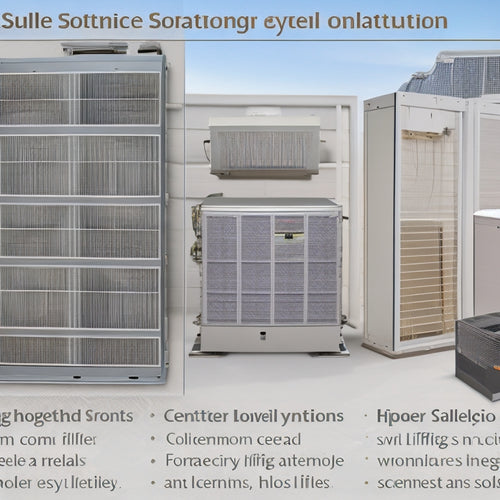
What Insulation Materials Best Reduce Home Energy Costs?
Share
You can reduce your home energy costs by selecting the right insulation materials that effectively prevent heat loss in winter and heat gain in summer. Fiberglass batts, spray foam insulation, and eco-friendly options like recycled denim and sheep's wool are top contenders. When choosing, consider factors like climate, budget, and personal preferences, as well as thermal performance indicators like R-value and thermal conductivity. Proper installation and maintenance are also essential for maximizing energy efficiency and cost reductions. By understanding the benefits and specifications of each material, you'll be well on your way to creating a more energy-efficient and sustainable home.
Key Takeaways
- Fiberglass batts offer a cost-effective solution with moderate R-value, reducing energy costs by preventing heat loss and gain.
- Spray foam insulation provides a higher R-value and better air sealing, resulting in significant energy savings and reduced utility bills.
- Cellulose insulation, made from recycled materials, offers a high R-value and thermal performance, making it an eco-friendly option for energy efficiency.
- Recycled denim and sheep's wool insulation are natural, renewable, and biodegradable options that reduce heat loss and support sustainable building practices.
- Proper installation and maintenance of insulation materials are crucial to maximize energy efficiency and cost reductions, ensuring optimal performance and longevity.
Benefits of Energy-Efficient Insulation
You can considerably reduce your home energy costs by investing in energy-efficient insulation. This is because it prevents heat from escaping during winter and entering during summer, allowing your heating and cooling systems to work more efficiently.
As a result, you'll experience significant energy savings, which can lead to substantial reductions in your utility bills. Furthermore, energy-efficient insulation enhances comfort by maintaining a consistent indoor temperature and reducing drafts.
By implementing strategies like time-of-use rate optimization, you can further minimize energy consumption. Additionally, conducting energy audits can help identify areas of inefficiency in your home's infrastructure.
This means you can enjoy a cozy and peaceful living space without worrying about the environmental impact or financial burden of excessive energy consumption. By choosing the right insulation, you'll be free to live life on your own terms, without the weight of unnecessary energy costs holding you back.
Top Insulation Materials Compared
With energy-efficient insulation in place, the next step is to select the most suitable material for your home. You have several options to choose from, each with its unique characteristics, advantages, and disadvantages.
Fiberglass batts are a popular choice, offering an affordable and easy-to-install solution. They come with a moderate R-value, making them suitable for most climates.
By incorporating renewable energy sources into your home's energy infrastructure, you can further reduce your carbon footprint. Additionally, considering the environmental impact of your insulation material can also contribute to a more sustainable living space.
On the other hand, spray foam insulation provides a higher R-value and better air sealing, but it's more expensive and requires professional installation.
Consider factors like climate, budget, and personal preferences when making your decision. By assessing the pros and cons of each material, you can make an informed choice that best suits your needs and maximizes energy savings.
Thermal Performance of Insulators
Three key factors determine the thermal performance of an insulator: its R-value, thermal conductivity, and mean temperature. You need to take into account these factors when selecting an insulation material to maximize energy savings.
| Insulation Material | R-Value per Inch | Thermal Conductivity (W/mK) |
|---|---|---|
| Fiberglass Batts | 3.1-4.3 | 0.035-0.040 |
| Cellulose Insulation | 3.5-3.8 | 0.039-0.042 |
| Spray Foam Insulation | 5.0-6.5 | 0.020-0.030 |
Thermal conductivity measures how well a material conducts heat. A lower thermal conductivity indicates better insulation performance. Insulation thickness also plays a significant role, as it directly affects the R-value of the material. By understanding these factors, you can make an informed decision about the best insulation material for your home.
Eco-Friendly Insulation Options
How environmentally conscious are your insulation choices?
When it comes to eco-friendly insulation options, you have several alternatives to traditional fiberglass. One popular choice is recycled denim insulation, made from recycled jeans and other denim products. This sustainable material has a high recycled content, reducing waste and conserving natural resources.
Another eco-friendly option is sheep's wool insulation, a natural, renewable resource that's biodegradable and non-toxic. Both of these materials provide excellent thermal performance, reducing heat loss and energy costs.
Insulation Installation and Maintenance
Proper insulation installation is key to maximizing energy efficiency and reducing heating and cooling costs. You need to guarantee that your insulation is installed correctly to reap the benefits.
Regular maintenance, including cleaning and inspecting connections, is essential for optimizing performance and ensuring longevity, just like solar panel maintenance practices. Achieving energy independence through sustainable infrastructure can also future-proof your home and support environmental goals.
-
Seal air leaks: Verify that all gaps and cracks are sealed to prevent air from escaping or entering your home.
-
Install correctly: Follow the manufacturer's instructions for installation, and make sure the insulation is fitted snugly around pipes, wires, and other obstructions.
-
Regularly inspect: Check your insulation regularly for signs of damage, compression, or settling, and address any issues promptly.
Frequently Asked Questions
Can I Install Insulation Materials Myself or Do I Need a Professional?
You can opt for DIY insulation, but it's essential to guarantee proper installation to maximize energy savings. If you're not comfortable with the process, consider hiring a professional for a precise installation that meets local building codes.
How Long Does Insulation Typically Last Before Needing Replacement?
You'll typically get 20-30 years of service from your insulation before it needs replacement, but you'll know it's time when you notice decreased energy efficiency, water damage, or pest infestations - all indicators that it's time to reassess your insulation lifespan.
Are There Any Insulation Materials That Can Be Used in Historic Homes?
When preserving historic homes, you'll want to balance historic preservation with energy efficiency. You can use materials like fiberglass, cellulose, or recycled denim, which are compatible with historic structures and meet energy efficiency standards, ensuring a comfortable, eco-friendly living space that honors the past.
Can I Use Insulation Materials in Outdoor Structures Like Garages or Sheds?
You can definitely enhance garage efficiency by adding outdoor insulation to your structure, providing a cozier space while slashing energy bills; consider using foam board, radiant barrier, or fiberglass batts for ideal results in your garage or shed.
Do Insulation Materials Come With Warranties or Guarantees?
You'll find that many insulation manufacturers offer warranties or guarantees, typically ranging from 10 to 50 years, covering defects, performance, and even energy savings, giving you peace of mind and protection for your investment in insulation warranties and guarantees.
Related Posts
-

Why Solar HVAC Filters Revolutionize Home Energy Efficiency
By adopting solar HVAC filters, you're shifting your home's energy reliance from fossil fuels to clean, renewable sou...
-

Why Biodegradable Dish Soap Matters for Earth-Conscious Homes
You likely don't realize that the dish soap you're using today will still be harming the environment long after you'v...
-

Why Grow Up? Vertical Gardens Transform Urban Living
As you change your urban living space, you're not just growing up - you're bringing nature back into the heart of the...


